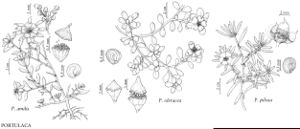Portulaca amilis
Anales Soc. Ci. Argent. 92: 104, plate 6. 1921.
Plants annual; roots fibrous. Stems prostrate to suberect; trichomes dense at nodes and in inflorescence; branches 5–25 cm. Leaf-blades oblanceolate, spatulate, or obovate, flattened, 5–30 × 2–12 mm, apex acute to submucronate; involucrelike leaves 6–8 (–9). Flowers 5–20 mm diam.; petals pink to purple, obovate, 7–10 × 4–8 mm; stamens 15–45; stigmas 7–10. Capsules ovoid, 2–5.5 mm diam. Seeds black, orbiculate, flattened, 0.4–0.6 mm diam., shiny; surface cells obscurely stellate, tuberculate to ± smooth. 2n = 18.
Phenology: Flowering late spring–early fall.
Habitat: Fields, granitic outcrops, disturbed habitats
Elevation: 0-200 m
Distribution

Introduced; Ala., Fla., Ga., N.C., S.C., South America
Discussion
Prior to 1981, Portulaca amilis had been included conceptually within P. pilosa (A. E. Radford et al. 1968). However, W. S. Judd and R. P. Wunderlin (1981) correctly identified P. amilis as an introduction from South America. It tends to occur in the sandy soils at the junction of the coastal plain and the piedmont provinces, but it is also spreading north and south through the coastal plain, where it has exhibited a weedy nature, as shown by collection data from Virginia to Florida. Portulaca amilis has only pink to purple petals in the United States; C. D. Legrand (1962) reported a yellow form of the species in South America. A. F. Clewell (1985) incorrectly gave the petal color of P. amilis as yellow. J. F. Matthews and P. A. Levins (1985) traced the spread of the species in the southeast and theorized as to the means of introduction.
Selected References
None.
